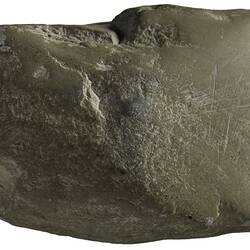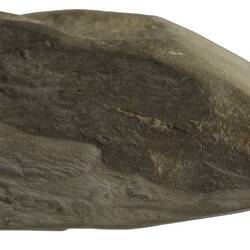Summary
The heaviest and most durable material available to Aboriginal people across Australia was stone. The use of metal was unknown until Aboriginal people had contact with Indonesian fisherman in the Northern Territory in the 17th century, and later with Europeans.
This axe was used as a chopping tool, its straight cutting edge formed by grinding. Aboriginal craftsmen made 'axe blanks' by striking large flakes of stone from rocky outcrops. These were roughly shaped on site and often finished away from the quarry. Grinding was usually done at axe-grinding sites on sandstone outcrops, which were often located near a river. Men sometimes carried axe blanks across great distances for trading. The exact provenance of this axe is unknown.
While not as sharp as a chipped stone tool, the edge of this axe is much more durable. When broken or chipped, the edge could be re-sharpened repeatedly. The edge on this axe has been ground to a smooth glossy finish.
Physical Description
Ground axe; petrified wood. Unhafted hatchet/axe-head. Ground-edged. Polished. Light grey-coloured stone. Adhesive label reads 'Mrs [illegible] [illegible], S. Australia'.
Significance
Throughout Australia, Aboriginal people used axes to cut down small trees, to chop wood, to remove tree bark for canoes and shelters, to butcher large animals and to undertake many other tasks. Axes were used to make footholds in the trunks of trees and to enlarge holes in trees to access small animals. Axes were also used as weapons, ceremonial objects and as valuable trade items.
More Information
-
Object/Medium
Stone artefact
-
Maker
-
Locality
-
Collector
-
Fully Extended
90 mm (Length), 55 mm (Width), 40 mm (Height)
-
Classification
-
Date Made
-
Maker
-
Clan/Language Group
-
Place Made
-
Indigenous Region
-
Collection Names
-
Type of item
-
Discipline
-
Category
-
Collecting Areas



